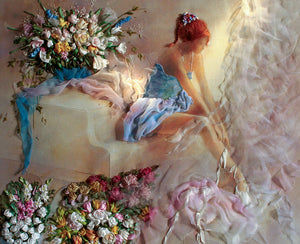# Type at least 1 character to search # Hit enter to search or ESC to close
FREE SHIPPING for all orders over $200 ♡♡♡
Welcome to my Blog. This a place to share and learn all things embroidery. Here I post inspirational stories and free lessons in the form of tutorials and guides. I also share tips, tricks and teach stitches and techniques.
You will also find free patterns and designs for you to unlock your creativity. It is a great place for any creative looking to learn or find inspiration in this art form.
To stay in the loop with Dicraft you can subscribe to my newsletter and stay in touch on Instagram and Facebook.
Browse by Category
Recent Posts
- September 2025
- July 2025
-
- Happy World Embroidery Day 2025!
- Silk Ribbon Embroidery Hint 14 by Di van Niekerk
- Silk Ribbon Embroidery Hint 13 by Di van Niekerk
- How to Make Stumpwork Wings from Organza Ribbon or Fabric by Di van Niekerk
- Split Stitch by Di van Niekerk
- Blanket/Buttonhole stitch
- The Moth - Ribbon Embroidery and Stumpwork by Di van Niekerk in issue #127 of Inspirations Magazine
- How to Make a Lisianthus Flower (or Rose Bud) in Silk Ribbon - by Di van Niekerk
Browse By Category:
Latest Posts:
Indonesia. Bandung Jawa Barat
Our stockist in Bandung Jawa Barat, Indonesia Crayon's Craft & Co are friendly and experienced and they keep all my products. Click on the images to enlarge Yoyong is a pleasure to know and you are welcome to contact her with any queries or for my books, panels, DVDs and ribbons. ...
South Africa. Delareyville. North West Province
Our stockist in Delareyville North West Province Fantasie Kuns Ina Uys is a highly experienced silk ribbon embroidery teacher and she stocks my panels, books and ribbons. When next you are in the area, do call Ina to find out where she is holding her next class - you won't be disappointed! Click on images to enlarge ...
South Africa. Scottburgh, KwaZulu Natal.
Stockist in Scottburgh, on the beautiful South Coast of KwaZulu Natal. Carol’s Yarn Barn. Click on the images to enlarge Carol Anne Anderson owns and runs her gorgeous boutique form the popular sea side town of Scottburgh. Carol’s Yarn Barn stocks all my ribbons, books and printed panels. ...
South Africa. Gonubie, East London.
Our stockist in Gonubie, East London BlueBugz Crafts Click on the images to enlarge Ashleigh Baker of BlueBugz Crafts (formally Bluebells) which is located about 150 metres from the sea and Boardwalk in the most beautiful “village” of Gonubie, wrote: We have a very comfortable and relaxed little shop where we are so privileged...
South Africa. Uvongo, KwaZulu Natal
Our stockist in Uvongo, Natal Albie Wentzel – our stockist and teacher from Uvongo, on the beautiful South Coast of Natal, is a gifted embroiderer and teacher. I had the pleasure of meeting Albie at Hobby-X in Johannesburg and her friendly, kind personality is what makes her such a good teacher. Her students love her! Albie is a talented...
USA. Staten Island, New York, 10305
Our stockist in Staten Island, NY, 10305 Ksenia Fabrykina of Stitching Favourites and MadameNeedle Click on images to enlarge Ksenia Fabrykina has an on-line store in Staten Island, NY, 10305, USA and she keeps my products: ribbons, printed panels, and books. Her website is translated to both languages: English and Russian. ...
Portugal. Maia
Our stockist in Maia, Portugal. Isa Banho, Vermoim, Maia click on the images to enlarge I had the pleasure of meeting Isa and her twin sister, Ivone, at Hobby-X in Johannesburg. Isa was on holiday in South Africa and on her way back to her home in Portugal. ...
South Africa. Polokwane (Pietersburg)
Our stockist in Polokwane (Pietersburg) Annatjie Zeelie Click on the images to enlarge Annatjie Zeelie has vast experience in silk and dimensional embroidery and her classes are very popular indeed. Situated on the Great North road to Zimbabwe, Polokwane is the heart of the Limpopo...
Russia. Moscow
Our stockist in Moscow Russia Raduga Hobby e-shop One of three exclusive dealers in Russia for my products and stores should contact Elena directly as a wholesale dealer of my products. Click on images to enlarge Elena Rostovskaya of Raduga Hobby e-shop stocks all my ribbons, panels, books and DVDs ...
South Africa. Secunda, Mpumalanga.
Our stockist in Secunda. Lientjie van Aardt has everything that you need for silk ribbon embroidery. She keeps my ribbons, panels and books and I am sure that you will enjoy the popular silk ribbon embroidery classes that she offers :)) ...
Shop Dicraft
Browse Dicraft
General Info
Get regular newsletters packed with tips, specials and new products!
Copyright © DI VAN NIEKERK. ALL RIGHTS RESERVED.


















